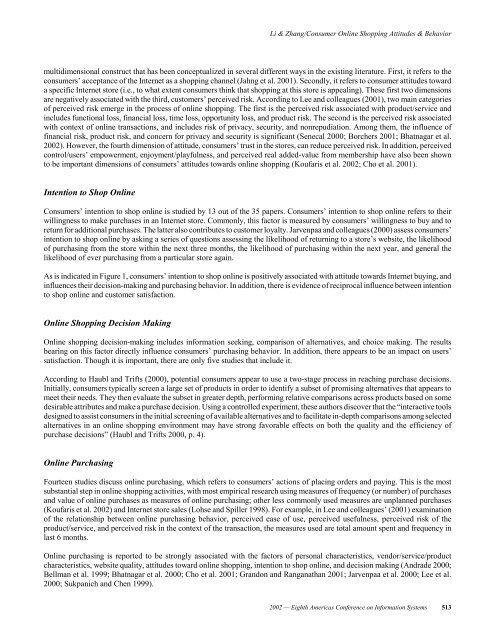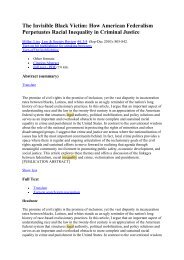Consumer Online Shopping Attitudes and Behavior: An ... - E-Journal
Consumer Online Shopping Attitudes and Behavior: An ... - E-Journal
Consumer Online Shopping Attitudes and Behavior: An ... - E-Journal
You also want an ePaper? Increase the reach of your titles
YUMPU automatically turns print PDFs into web optimized ePapers that Google loves.
Li & Zhang/<strong>Consumer</strong> <strong>Online</strong> <strong>Shopping</strong> <strong>Attitudes</strong> & <strong>Behavior</strong><br />
multidimensional construct that has been conceptualized in several different ways in the existing literature. First, it refers to the<br />
consumers’ acceptance of the Internet as a shopping channel (Jahng et al. 2001). Secondly, it refers to consumer attitudes toward<br />
a specific Internet store (i.e., to what extent consumers think that shopping at this store is appealing). These first two dimensions<br />
are negatively associated with the third, customers’ perceived risk. According to Lee <strong>and</strong> colleagues (2001), two main categories<br />
of perceived risk emerge in the process of online shopping. The first is the perceived risk associated with product/service <strong>and</strong><br />
includes functional loss, financial loss, time loss, opportunity loss, <strong>and</strong> product risk. The second is the perceived risk associated<br />
with context of online transactions, <strong>and</strong> includes risk of privacy, security, <strong>and</strong> nonrepudiation. Among them, the influence of<br />
financial risk, product risk, <strong>and</strong> concern for privacy <strong>and</strong> security is significant (Senecal 2000; Borchers 2001; Bhatnagar et al.<br />
2002). However, the fourth dimension of attitude, consumers’ trust in the stores, can reduce perceived risk. In addition, perceived<br />
control/users’ empowerment, enjoyment/playfulness, <strong>and</strong> perceived real added-value from membership have also been shown<br />
to be important dimensions of consumers’ attitudes towards online shopping (Koufaris et al. 2002; Cho et al. 2001).<br />
Intention to Shop <strong>Online</strong><br />
<strong>Consumer</strong>s’ intention to shop online is studied by 13 out of the 35 papers. <strong>Consumer</strong>s’ intention to shop online refers to their<br />
willingness to make purchases in an Internet store. Commonly, this factor is measured by consumers’ willingness to buy <strong>and</strong> to<br />
return for additional purchases. The latter also contributes to customer loyalty. Jarvenpaa <strong>and</strong> colleagues (2000) assess consumers’<br />
intention to shop online by asking a series of questions assessing the likelihood of returning to a store’s website, the likelihood<br />
of purchasing from the store within the next three months, the likelihood of purchasing within the next year, <strong>and</strong> general the<br />
likelihood of ever purchasing from a particular store again.<br />
As is indicated in Figure 1, consumers’ intention to shop online is positively associated with attitude towards Internet buying, <strong>and</strong><br />
influences their decision-making <strong>and</strong> purchasing behavior. In addition, there is evidence of reciprocal influence between intention<br />
to shop online <strong>and</strong> customer satisfaction.<br />
<strong>Online</strong> <strong>Shopping</strong> Decision Making<br />
<strong>Online</strong> shopping decision-making includes information seeking, comparison of alternatives, <strong>and</strong> choice making. The results<br />
bearing on this factor directly influence consumers’ purchasing behavior. In addition, there appears to be an impact on users’<br />
satisfaction. Though it is important, there are only five studies that include it.<br />
According to Haubl <strong>and</strong> Trifts (2000), potential consumers appear to use a two-stage process in reaching purchase decisions.<br />
Initially, consumers typically screen a large set of products in order to identify a subset of promising alternatives that appears to<br />
meet their needs. They then evaluate the subset in greater depth, performing relative comparisons across products based on some<br />
desirable attributes <strong>and</strong> make a purchase decision. Using a controlled experiment, these authors discover that the “interactive tools<br />
designed to assist consumers in the initial screening of available alternatives <strong>and</strong> to facilitate in-depth comparisons among selected<br />
alternatives in an online shopping environment may have strong favorable effects on both the quality <strong>and</strong> the efficiency of<br />
purchase decisions” (Haubl <strong>and</strong> Trifts 2000, p. 4).<br />
<strong>Online</strong> Purchasing<br />
Fourteen studies discuss online purchasing, which refers to consumers’ actions of placing orders <strong>and</strong> paying. This is the most<br />
substantial step in online shopping activities, with most empirical research using measures of frequency (or number) of purchases<br />
<strong>and</strong> value of online purchases as measures of online purchasing; other less commonly used measures are unplanned purchases<br />
(Koufaris et al. 2002) <strong>and</strong> Internet store sales (Lohse <strong>and</strong> Spiller 1998). For example, in Lee <strong>and</strong> colleagues’ (2001) examination<br />
of the relationship between online purchasing behavior, perceived ease of use, perceived usefulness, perceived risk of the<br />
product/service, <strong>and</strong> perceived risk in the context of the transaction, the measures used are total amount spent <strong>and</strong> frequency in<br />
last 6 months.<br />
<strong>Online</strong> purchasing is reported to be strongly associated with the factors of personal characteristics, vendor/service/product<br />
characteristics, website quality, attitudes toward online shopping, intention to shop online, <strong>and</strong> decision making (<strong>An</strong>drade 2000;<br />
Bellman et al. 1999; Bhatnagar et al. 2000; Cho et al. 2001; Gr<strong>and</strong>on <strong>and</strong> Ranganathan 2001; Jarvenpaa et al. 2000; Lee et al.<br />
2000; Sukpanich <strong>and</strong> Chen 1999).<br />
2002 — Eighth Americas Conference on Information Systems 513














